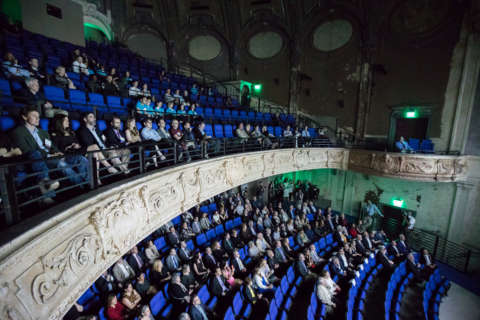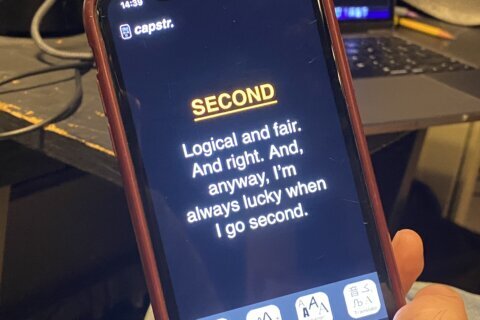WASHINGTON — It won four awards at the 2015 Cannes Film Festival before winning the Golden Globe for Best Foreign Language Film on Sunday and being nominated for an Oscar on Thursday.
Now, Hungary’s Holocaust drama “Son of Saul” finally hits D.C. movie theaters this weekend.
As you check out this Academy Award contender, it’s also the perfect time to stream Germany’s “Victoria,” unfolding in one continuous shot over 2 1/2 hours on the streets of Berlin.
Both films are set in very different German settings, both have bagged an array of international film festival prizes, and both are absolutely worth your time if you love daring European filmmaking.
Time for a double review of “Son of Saul” and “Victoria,” including a Q&A with the latter’s star, actress Laia Costa, who recently joined WTOP over the phone from a beach in Spain.
Interview below may contain some explicit language.
‘Son of Saul’
Director: László Nemes
Set in 1944, Hungarian native Saul Ausländer (Géza Röhrig) is interred at Auschwitz as a member of the “Sonderkommando,” a work group of Jewish prisoners forced to lead other inmates to the gas chambers, burn their bodies in the crematoriums and shovel their ashes into the wilderness.
One day, during his horrific daily duties, Saul encounters the body of a young boy. Fascinated by the young loss of life, he “adopts” the boy as his posthumous “son” and attempts to arrange a proper Jewish funeral for him, including a Rabbi reading last rites and an actual burial instead of incineration.
https://www.youtube.com/watch?v=3fpv0S8wE9Y
Directed by László Nemes in his first feature film, “Son of Saul” immediately feels like a different sort of picture than a more sentimentalized film like “Sophie’s Choice” (1982) or “Schindler’s List” (1993). We don’t flash back to the protagonist’s tearjerking back story like Meryl Streep in “Sophie,” nor do we get Liam Neeson breaking down in tears on Ben Kingsley’s shoulder like the end of “Schindler.”
Instead, the movie opens in jarring 4:3 aspect radio, displaying a static shot with a completely dirty frame (out of focus), until the protagonist walks toward the camera and gradually comes into focus.
As we follow Saul, the camera often hovers behind his head, just over his shoulders where an “X” is printed on his back. A similar style was used by Darren Aronofsky hovering behind Mickey Rourke in “The Wrestler” (2008) and Ava DuVernay hovering behind David Oyelowo in “Selma.” In “Son of Saul,” it brilliantly shows the weight of morality hanging on Saul’s shoulders in this Holocaust hell.
Because of the camera’s proximity to the actor and the director’s intense focus on his hero, we often can only guess at the atrocities occurring around him. You could argue the unseen is more horrific. Instead, we catch only glimpses — a lifeless limb here, a naked breast there — as the stripped dead bodies are dragged around the crematory, often out of focus in the peripheral of the 4:3 frame.
This style makes Röhrig’s performance all the more crucial, having to carry much of the movie with the posture of his shoulder blades and the expressions of his worn face, his eyes tuning out the violence to keep his eye on the prize of burying his “son.” Thus, Röhrig placed second for Best Actor at the Los Angeles Film Critics Awards behind only Michael Fassbender (“Steve Jobs”) and second for Best Actor at the National Society of Film Critics Awards behind only Michael B. Jordan (“Creed”).
Röhrig’s face — and the brilliant sound effects of gunfire, screams and barking dogs — suggest the fate of the fellow inmates at the camp. With this approach, don’t expect everything to be tidied up by the end, which leaves us with Röhrig’s tellingly optimistic facial expression amid the sound effects of inherent doom surrounding them. You could call this finale frustratingly ambiguous, or you could treat it as a game as to not only what happened, but what the hero was thinking when it happened.
This lack of hand holding is refreshing. At one point, a Nazi guard looks Saul in the face and says, “Hungarian is such an eloquent language.” You could say the same about this film, which just put Hungarian cinema back on the map. It’s already won Hungary its first Golden Globe for Best Foreign Language Film and is set up nicely to do the same at the Oscars. “Son of Saul” is the first Hungarian film since 1988 to be nominated for the Oscar, and if it pulls it off, will be the first to win it.

‘Victoria’
Director: Sebastian Schipper
While “Son of Saul” is a favorite to win the Foreign Language Oscar, “Victoria” was regrettably disqualified for having too much English dialogue blended with German and Spanish.
While this will unfortunately keep “Victoria” out of the Oscar race, it firmly establishes the film as one of the most underrated global gems of 2015 — and a must-watch On Demand. If you stream it on a small screen, please put away all digital devices and remove all potential distractions from view.
“Victoria” deserves to be seen without interruption to fully appreciate its masterful long continuous shot that lasts the entire 138 minutes during the early morning hours of modern-day Berlin.
It follows Victoria (Laia Costa), a Spanish native who has moved to Berlin, where her flirtations with a charming club patron, Sonne (Frederick Lau), spark a dangerous night on the town with his buddies. By the end, you’ll quote “Black Swan” director Darren Aronofsky: “‘Victoria’ rocked my world.”
Of course, “Victoria” is not the first movie to achieve this. Alfred Hitchcock attempted it back in “Rope” (1948) but lacked the technology to fully achieve it, masking his cuts each time the film stock ran out. Since then, we’ve seen similar single-take efforts in Alexander Sokurov’s “Russian Ark” (2002), Gus Van Sant’s “Elephant” (2003) and Alejandro G. Iñárritu’s “Birdman” (2014).
“They all play with this format, but the three of them are completely different,” Costa tells WTOP.
Indeed, German director Sebastian Schipper knew from the start that his film would be gritty.
“When we were starting the rehearsals in Berlin last year, I was a big fan of ‘True Detective,’ so I saw these (six-minute) single shots of ‘True Detective’ … and then I mailed Sebastian the director and I said, ‘Look! That’s amazing man!’ He was like, ‘Yeah, but our one-take is going to be punkier, it’s not going to be perfect, it’s going to be like the war journalists … just trying to steal the picture.'”
Schipper achieved the amazing feat after just three takes, hitting his carefully choreographed marks with the precision of cinematographer Sturla Brandth Grøvlen, who won Best Cinematography at the German Film Awards and the prestigious Silver Bear at the Berlin International Film Festival.
“There’s a lot of technical stuff that has to be correctly done. I knew that I have to be careful at this point because I need to help Sturla, the cameraman, pass through the door, or I need to get into the car like this, because the boys are going to do that, or you have to remember that the blood is going to be hidden in that tree, so you have to go there and take the blood and smash it in your stomach.”
There is a brief moment where a background extra accidentally steps into the frame as Victoria and Sonne enter a hotel, but such minor glitches are to be expected in such an elaborate long-take.
“The streets were not controlled, so people from the street all the time were interfering. At one point, Blinker, he has a panic attack in the street, so there were like a couple of Russian guys, they were a little bit drunk maybe, they were looking at us thinking, ‘Oh my God! These guys need some help!’ So they came to us and the director, Sebastian, was hidden inside the car (shouting), ‘It’s a film! Don’t go there! It’s a film!’ And they start fighting. That was happening just three meters from us.”
Beyond the technical achievements and real-time logistical distractions, the filmmakers also make sure to craft a truly engrossing story. At the midpoint, the film masterfully shifts tones from a rambunctious nightclub romance to a gripping crime thriller, starting with a chance romantic meeting between two strangers like Richard Linklater’s “Before Sunrise” (1995), then shifting toward the danger of Tom Tykwer’s “Run Lola Run” (1998), in which Schipper actually starred as Mike.
https://www.youtube.com/watch?v=FNFGKXQGoIc
These brilliant tonal shifts showcase Costa’s unexpected talent, as we actually feel like she’s falling for Sonne while making hot cocoa in the coffee shop or playing the piano in her apartment.
“I think it’s just about being there and being concentrated. If you have rehearsed before and you know your character and you know what’s going on in all the locations, and you know what’s the conflict, what’s the objective and who are you basically, then you can just do the scene,” she says.
Costa’s performance is not unlike Lorraine Bracco during her Copacabana single-take in Martin Scorsese’s “Goodfellas” (1990), swept along with criminals, sensing something is awry, braving the danger due to intrigue, and rising to the occasion to hold her own in a world of moral dilemma.
“Today we have a lot of friends like, let’s do a coffee today and maybe one more in a couple weeks. (‘Victoria’ is about) not that kind of friendship, but, ‘I’m f***ed up. I have to do something really bad. Are you going to be with me?’ That kind of friendship is something quite different,” Costa says.
The entire performance builds to an emotionally devastating final scene, sobbing and slobbering on the floor before picking herself up and moving on — a changed woman. As she confidently strolls down the streets of Berlin toward the end credits, you’ll be shocked to learn that she only recently began acting in 2012 after spending the first 17 years of her life playing basketball in Spain.
Thus, she’s still perfecting her craft and studying the greats. Her favorites? Gena Rowlands in John Cassavettes’ “A Woman Under the Influence” (1974), Holly Hunter in Jane Campion’s “The Piano” (1993), Isabelle Huppert in Michael Haneke’s “The Piano Teacher” (2001) and Emily Watson in Lars Von Trier’s “Breaking the Waves” (1996). Who knows? We may one day put Costa in the same class.
“If I’m like 90 years old and I’m with my grandchildren and some journalist is starting to say this, I will think, OK, now I can die happily. That’s magic. But to know this kind of thing, you need time. You need years in between. It’s nothing that I can say, or someone can say, it’s something that time says.”
Yes, time is the ultimate single-take.

The above ratings are based on a 4-star scale. See where these films rank in Jason’s Fraley Film Guide. Follow WTOP Film Critic Jason Fraley on Twitter @JFrayWTOP.
Listen to the full interview with Laia Costa at the top of this review.








